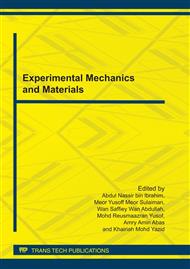[1]
F. Andreatta, H. Terryn & J.H.W. de Wit, Corrosion behaviour of different tempers of AA7075 Aluminium alloy, Electrochimica Acta, Vol 49, pp.2852-2862, (2004).
DOI: 10.1016/j.electacta.2004.01.046
Google Scholar
[2]
J. Blain, J. Masounave and J. I Dickson, A Comparison of SCC Velocity Measurement under Conditions of Constant Load and Constant Displacement, Corrosion Science, Vol. 24, No. 1, 1984, pp.1-12.
DOI: 10.1016/0010-938x(84)90131-8
Google Scholar
[3]
W.Y. Chu, C.M. Hsiao & J.W. Wang, Stress corrosion cracking of an aluminium alloy under compressive stress, Metallurgical Transactions A, Vol 16A, 1985-1663, (1985).
DOI: 10.1007/bf02663022
Google Scholar
[4]
M.J. Robinson & N.C. Jackson, Exfoliation corrosion of high strength Al-Cu-Mg alloys: effect of grain structure, British Corrosion Journal, Vol 34, No1, 45-49, (1999).
DOI: 10.1179/bcj.1999.34.1.45
Google Scholar
[5]
M.O. Speidel, Theory of stress corrosion cracking in alloys, Edited by J.C. Scully, Published NATO, Brussels, p.295, (1971).
Google Scholar
[6]
STP G34, Test for exfoliation corrosion susceptibility of 7XXX series copper-containing aluminium alloys, (EXCO) test, ASTM, Philadelphia, PA, (1979).
DOI: 10.1520/g0034-01
Google Scholar
[7]
N.J.H. Holroyd, Environmental-induced cracking of high-strength aluminium alloys, Environment-Induced Cracking of Metals Proceedings, NACE, pp.311-345, (1989).
Google Scholar
[8]
R.C. Dorward, K.R. Hasse & W.J. Helfrich, Marine atmosphere stress corrosion tests on precracked specimens from high strength aluminium alloys: effect of corrosion product wedging, Journal of Testing and Evaluation, Vol 6, No 4, pp.268-275, (1978).
DOI: 10.1520/jte10953j
Google Scholar
[9]
R.C. Dorward & K.R. Hasse, Flaw growth in high strength Al-Zn-Mg-Cu Alloys exposed to stress corrosion environments, Corrosion, Vol 34, No 11, pp.386-395, (1978).
DOI: 10.5006/0010-9312-34.11.386
Google Scholar
[10]
D. McNaughtan, M. Worsfold & M.J. Robinson, Corrosion product force measurements in the study of exfoliation and stress corrosion cracking in high strength aluminium alloys, Corrosion Science, 45, pp.2377-2389, (2003).
DOI: 10.1016/s0010-938x(03)00050-7
Google Scholar
[11]
T. Kamimura & M. Stratmann, The influence of chromium on the atmospheric corrosion of steel, Corrosion Science, Vol 43, No 3, pp.429-447, (2001).
DOI: 10.1016/s0010-938x(00)00098-6
Google Scholar
[12]
T.H. Nguyen, B.F. Brown & R.T. Foley, On the nature of the occluded cell in the stress corrosion cracking of AA 7075-T651 – effect of potential, composition, morphology, Corrosion, Vol 38, No 6, pp.319-326, (1982).
DOI: 10.5006/1.3621692
Google Scholar
[13]
R.T. Foley, Localised corrosion of aluminium alloys, Corrosion, Vol 42, No 5, pp.277-288, (1986).
Google Scholar
[14]
M.J. Robinson, The role of wedging stresses in the exfoliation corrosion of high strength aluminium alloys, Corrosion Science, Vol 23, No 8, pp.887-899, (1983).
DOI: 10.1016/0010-938x(83)90016-1
Google Scholar
[15]
M.O. Speidel, Current understanding of stress corrosion crack growth, Published in The theory of stress corrosion cracking in Alloys, Editor J.C. Scully, NATO, Scientific Affairs Division, Brussels, pp.289-344, (1971).
Google Scholar
[16]
D.A. Vermilia, A film rupture model for stress corrosion cracking, Published in 'Stress corrosion cracking and hydrogen embrittlement of iron based alloys, NACE, Houston, TX, pp.208-217, (1978).
DOI: 10.1016/b978-0-08-100049-6.00007-0
Google Scholar
[17]
W.R. Middleton & R.N. Parkins, Stress corrosion crack pathways in Al-Zn-Mg alloys, Corrosion, Vol 28, No 3, pp.88-94, (1972).
DOI: 10.5006/0010-9312-28.3.88
Google Scholar


